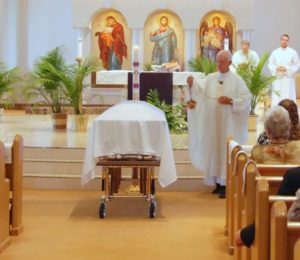
Credit: churchsupplywarehouse.com
When I worked as a hospice social worker, the care team often attended the funerals of clients who had died. I saw many ceremonies that were beautiful and meaningful, but the one that touched me most was the Catholic funeral Mass, especially after our chaplain explained to me what was expected as a non-Catholic attendee.
Like all services, each Catholic funeral Mass has variations and ways to personalize the service. In general, though, each funeral has three parts: the Vigil, the Mass and the Committal.
The Vigil usually takes place the night before the Mass in the home of the person who died or at the church they attended. Visitors share stories. Some bring refreshments. There is no provision for a eulogy during the Mass, so eulogies take place at the Vigil.
The Catholic funeral Mass is celebrated the next day. However, the Church prohibits Mass on certain days when. For instance, there can be no funeral Mass on Sundays during Advent or Sundays during Lent or Easter Season (the 50 days following Easter). The Church also prohibits funeral Masses during the time between Holy Thursday and Easter Sunday.
The Catholic Funeral Mass is a ceremony led by a priest or, in some cases, by a deacon. If the body of the person who died was cremated, the Church refers to the ceremony as a memorial Mass. If the body of the person is present, it calls it a funeral Mass.

Credit: st-raphaels.com
In either case, the ceremony involves religious music, reading of the scriptures and prayer. Sometimes the priest sprinkles holy water on the casket and burns incense to honor the dead. Catholics believe that when the body dies, the soul goes to heaven, purgatory or hell. Spirits in purgatory stay there until they have made up for their sins. Then they move on to heaven. Catholics believe that praying for their loved ones can shorten their time in purgatory. That is the purpose of the prayers they offer during the mass.
The Committal ceremony takes place when the body is placed in the ground or in a mausoleum. Only family and close friends usually attend. The Catholic Church allows cremation, but it disapproves of the scattering of ashes.
How to Behave at a Catholic Funeral Mass
Going to a Catholic funeral Mass if you are not Catholic can be confusing because of all the different rites and rituals. These tips may help:
Standing and sitting: You should sit and stand as the priest directs.
Kneeling: Some people are uncomfortable with kneeling in a church because it is not part of their worship services. The Church doesn’t require that you kneel if you choose not to. Nor does it prohibit you from doing so if you wish. If the idea bothers you, just remain seated and no one will think any less of you.
Communion: If you are not Catholic, do not take Communion at a Catholic funeral Mass. The Church forbids it. Simply stay seated when the priest calls people to the front of the church. Don’t worry about being conspicuous. Several others are sure to remain seated as well.
Catholicism is the largest religious denomination in the United States. So you will probably attend a Catholic funeral Mass at some point in your life. This article offers some tips on what you can expect and how you should behave.

 The Traditions and Customs of Catholic Funeral Mass
The Traditions and Customs of Catholic Funeral Mass


 Recovering Cremation Remains After the Los Angeles Fires
Recovering Cremation Remains After the Los Angeles Fires
 “As Tears Go By” by Marianne Faithfull
“As Tears Go By” by Marianne Faithfull
 “The Sea” by John Banville
“The Sea” by John Banville














